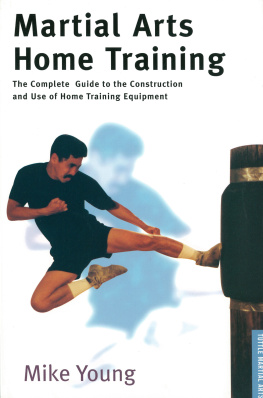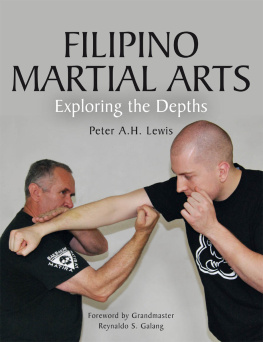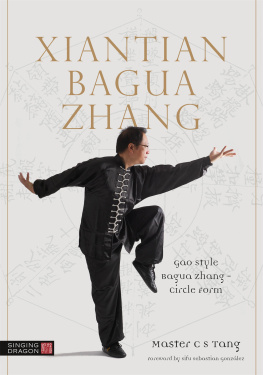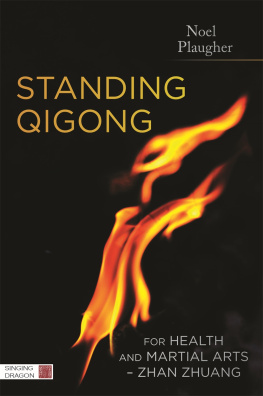
The Complete Book of
YIQUAN
by the same author
The Mysterious Power of Xingyi Quan
A Complete Guide to History, Weapons and Fighting Skills
Master C S Tang
ISBN 978 1 84819 140 2
eISBN 978 0 85701 115 2
of related interest
The Essence of Taijiquan Push-Hands and Fighting Technique
Wang Fengming
ISBN 978 1 84819 245 4
eISBN 978 0 85701 190 9
XinYi WuDao
Heart-MindThe Dao of Martial Arts
Master Zhongxian Wu
Foreword by Grandmaster Zhao ShouRong
ISBN 978 1 84819 206 5
eISBN 978 0 85701 156 5
The Four Dragons
Clearing the Meridians and Awakening the Spine in Nei Gong
Damo Mitchell
Foreword by Dr Ole Saether
ISBN 978 1 84819 226 3
eISBN 978 0 85701 173 2
The Complete Book of
YIQUAN
Master C S Tang

LONDON AND PHILADELPHIA
First published in 2015
by Singing Dragon
an imprint of Jessica Kingsley Publishers
73 Collier Street
London N1 9BE, UK
and
400 Market Street, Suite 400
Philadelphia, PA 19106, USA
www.singingdragon.com
Copyright C S Tang 2015
All rights reserved. No part of this publication may be reproduced in any material form (including photocopying or storing it in any medium by electronic means and whether or not transiently or incidentally to some other use of this publication) without the written permission of the copyright owner except in accordance with the provisions of the Copyright, Designs and Patents Act 1988 or under the terms of a licence issued by the Copyright Licensing Agency Ltd, Saffron House, 610 Kirby Street, London EC1N 8TS. Applications for the copyright owners written permission to reproduce any part of this publication should be addressed to the publisher.
Warning: The doing of an unauthorised act in relation to a copyright work may result in both a civil claim for damages and criminal prosecution.
Library of Congress Cataloging in Publication Data
A CIP catalog record for this book is available from the Library of Congress
British Library Cataloguing in Publication Data
A CIP catalogue record for this book is available from the British Library
ISBN 978 1 84819 225 6
eISBN 978 0 85701 172 5

T HE T HINKER (F RENCH : L E P ENSEUR )
A bronze and marble sculpture by Auguste Rodin held in the Muse Rodin in Paris. It depicts a man in sober meditation battling with a powerful internal struggle.
CONTENTS
FOREWORD
In Chinese martial arts, the concepts and ideas have always prevailed over the techniques. Many styles have a number of forms of linking movements with weapons and void-hand, but in the end, the point is to develop a skill or quality which is described as kung fu.
Every artistic expression, such as painting, calligraphy, poetry, and seal engraving, for example, can show this level through its realization or kung fu. Thus, when we look at an artist while doing a masterpiece, we can say that his kung fu is really good or he has that thing we dont know how to describe but that reveals a high level of execution.
Kung fu means time and effort, and it has two aspects. On the one hand, it requires a technique which can be learned; and on the other hand, a skill which cannot be learned. This skillfulness can only be developed through time and practice, and it is tied to the spirit of the person.
The difference between a masterpiece made by an artist and a good copy of a specialist lies in how much time and effort the artist has devoted to refining his spirit. In martial arts, the difference would be this refinement together with technique, as a result of the experiences, training, and apprenticeship under a qualified master.
Master C S Tang is an artist and a master of internal martial arts; master of Bagua Zhang, Yiquan, Taiji Quan, and Xing Yi Quan; and an artist in seal engraving and calligraphy. Through this book, you can read about and learn this technique in a very detailed way. You will also be imbued with the spirit of the artist that expresses emotions and ideas.
This book is unlike most books of today. It is not one of those books with the air of having been written in a single day, out of several books that were read the night before. But just the oppositethere are many stories, anecdotes, teachings, and instructions about Yiquan, which have been recollected over many years of learning and experience by the teaching of this master.
Master C S Tang has been gathering all this knowledge and experience from the authentic Yiquan masters, distilling with time his own art and way to shape Yiquan; and, at the same time, representing a faithful development of the original style, but without losing the individual form of an artist who knows how to create his personal way.
Yiquan is a system developed by the famous martial artist Wang Xiang Zhai () on the basis of three internal martial arts: Xing Yi Quan, Bagua Zhang, and Taiji Quan. From painstaking investigation and innovation throughout his life, he developed a unique and direct system which increases health and martial aspects in a quicker and more efficient way.
In China there are many kung fu systems which go from the branches to the trunk. That is to say, they build up the martial artist in many indirect aspects, to finally reach the most important target: to economize movements and make them effective. Yiquan directly trains this aspect without getting lost among the branches. It goes direct to the trunk or root of internal martial arts and is considered as the heart of internal styles.
The essence of Yiquan is the practice of static stances, so is worthy for both our health and martial arts. To discover that the origin of any movement lies in quietness is a unique experience. It can only be understood when experienced through practice. But the most important thing that one will discover is the value of the intention (Yi) training which, applied to martial arts, turns the mind of the fighter into a powerful tool and the mind of the common practitioner into a strong mind, ready for action and with a positive and happy attitude towards life.
Master C S Tang, with his wide experience and idiosyncrasy, shows in a very clear way many aspects of the system, not yet revealed to the occidental world, that make this book a very valuable work which cannot be left aside hastily, but is to be read and re-read conscientiously.
Since I began learning martial arts, over 30 years ago, I have always heard Master saying that the external styles process is to evolve to the internal, developing aspects which are more characteristic of internal styles such as relaxation, economy of movement, adherent force, concentration, intention, and spirit.
You can directly find all these points in Yiquan, and what is valuable is that you can use it to improve your own martial art system or your health. Yiquan emphasizes all those aspects which have been lost in many kung fu styles or which are only trained in advanced levels.
To have participated in this book has been a great responsibility and tremendous luck for me. As the Spanish publisher, I have been able to transmit to the occidental world a knowledge that springs up from the very Chinese traditional culture, so that the dream of the great martial artist Wang Xiang Zhai through his students and through Master C S Tang, third direct generation of the founder of the system, may spread all over the occidental world, as food for the following generations.
Next page













